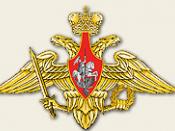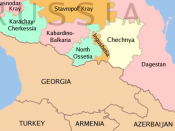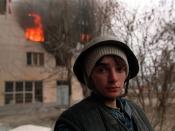Chechnya is a very small Autonomous Republic to the south of the Russian mainland, just north of Georgia. Its population generally remains that of a mid-sized American city: about one million inhabitants. Chechnya is complicated because of the copious teips, which are ethnic groups organized through common ancestry and geographic location (1-17). "Blood feuds" be- tween warring factions of 'pure' and 'impure' Chechens have been common and incessant since the beginning of the eighteenth century. Chechen dependance on Russia (or the USSR, after 1917 and before 1989) has periodically become a problem for the 'pure-blooded' teips, who mostly reside in the state's southern mountainous region and desire complete liberty from Kremlin.
The goal of the militant Chechens was and remains the independence of Chechnya and the cession of Russian military maneuvers in all areas within established boundaries. However, the explicit, opposing ambition of Kremlin officials, including executives such as president Boris Yeltsin was to disarm the Chechen rebels and maintain the stability of the Russian Republics. Russian authorities, military forces, and political figures consistently acted excessively, even to the point of exacerbating the growing Chechen threat.
The First Chechen National Assembly convened in November, 1990; it declared the for- mation of the Chechen Republic of Nochchi-Cho (also Ichkerija{1-18}) and elected Dzokhar Dudajev to its executive committee (2-117). Nominally, there was importance to the renaming of Chechnya, as it signified a break with Kremlin, as it had no permission thereof, and indicated Chechen rule would be dominated by the southern teips, of which Dudajev was a member (1-31). Subsequently, Chechnya declared its independence of Russia in the Second Chechen National Congress and held formal parliamentary elections in late September, which weren't recognized by Russian authorities because a number of regions within the state, including Nadterechno re- fused to participate.
As punishment - or action that raise the cost of non-compliance - for allowing the elec- tions, Yeltsin declared martial law in Chechnya and demanded the arrest of Dzhochar Dudajev (1-20). Dudajev met further internal opposition from Avturchanov and Khasbultov, partially be- cause Dudajev demanded the recall of all Chechen representatives to Russian Parliament. Russia deployed troops, which approached Chechen borders in late 1992 (1-21). Dudajev utilized a cost- ly signal by arranging his own tanks against Russia, to indicate that if the opposition troops pro- ceeded, they would be punished with shelling. This move made Russia more open to negotia- tions, wherein the Russian Minister of Peace attempted to convince Dudajev via persuasion - or actions taken by one actor to alter the behavior of another - that total sovereignty was neither in Chechnya's nor Dudajev's favor and was impossible; it would be crushed by Russian military might.
January 31, 2007 Political Science 160-002
UMID: 70084250 The First Chechen War and the Four Faces of Power
- 1 -
Dudajev decidedly abolished all pro-Russian activity, which met him with domestic op- position, backed by Russian funding and military equipment, as well as armed forces. Eventual- ly, Ingushia and Chechnya split and the opposition enjoys significant gains, including the capital city of Grozni (1-23). Dudajev and other rebel forces were able, very successfully, to defend their positions in southern mountains by applying gorilla warfare in small battalions, albeit suf- fering innumerable casualties.
In order for the Russian Kremlin to legitimize its operation in Chechnya to the internatio- nal community, it declared Chechnya an "antidemocratic, criminal regime" and confounded an irrelevant causation with the 'Chechen mafia' (1-27,28) and attempted to appear determined to simply disarm Dudajev's militants. However, a significant number of commanders were removed from duty, so "everything would move in the direction intended by Moscow's plans" (1-186). These military leaders were presumably those who wanted to be categorical and precise when carrying out maneuvers, to minimize civilian casualties.
Exhibitions of excessive Russian force are exemplified through massive emigration of Chechen citizens to bordering states (3-18). These refugees and those kept from returning to Chechnya by Russian authorities were denied basic medical care and relied on the inconsistent prescience of EMERCOM, UNICEF and other international organizations for food and drinkable water (3-9).
Furthermore, multifarious witnesses, including Russian and Chechen fighters and civil- ians, claim that the "scorch the earth" tactics exercised "did not inflict much damage to the Chechen Armed Forces" (1-297). Of the 427 communities that had existed before the war, Russ- ian forces destroyed 382 and the Chechen population halved (~470,000). Russia used X-29, X-25, C-25 guided surface to surface rockets - 200 to 400 meters in length - and heavy bombs, to attack civilian targets (3-27). There are countless chronicles of rape and murder committed by Russian military, often after encouragement and under scrutiny by superior commanders. Peter Bouckeart, Senior Emergencies Researcher for the Human Rights Watch declared Russian should be held accountable in European international court and determined there should be "no business as usual" between Russian and the US, as long as the 'genocide' continued (3-20). These measures go beyond punishment; these actions appear as unilateral, wherein Kremlin clearly had goals outside of disarmament of combatants. These actions constitute the use of force.
In 1999, the Chechnya Meeting of the Senate Committee of Foreign Relations deter- mined that Chechen military action occurred as a necessary means of self-defense, the Russian military used disproportionate measures of force, Chechnya and Russia had not undergone peaceful negotiations, and that the human rights problems were legitimate and had been overseen by international authorities, partially due to lack of access. The Committee recommended that Russia cease all operations in Chechnya, allow international organizations to penetrate and in- vestigate the refugee camps, and for President Clinton to engage Putin and Chechen leaders in peace and condemn Russian behavior (3-41).
- 2 -
- 2 -
While there is significant ambiguity concerning the legitimacy of Chechen authority and confusion surrounding the reality and significance of terrorist acts, it is thoroughly concluded that Russian tactics were excessive. Of the four faces of power, Kremlin arguably only used two: punishment and force. The transition from punishment to force occurs in the area of inundation of Russian military resources, at the cost of civilian lives and the livelihood of citizens in the re- gion. There are various occasions wherein Russia may have attempted to convince Dudajev to disarm and accept Russian sovereignty, however Dudajev and his supporters comprised a minor- ity of the population and Russia never made any real concessions to the Chechens. Of course, ac- tions that make the target more likely to comply, or rewards, were apparently not a viable option.
Furthermore, the conflict was perpetuated by lack of foreign intervention. On the part of the US, none was taken because the administration preferred to mend relations with Putin after NATO bombing in Yugoslavia.
January 31, 2007 Political Science 160-002
UMID: 70084250 The First Chechen War and the Four Faces of Power
- 3 -
Works Cited
1. Stasys Knezys & Romanas Sedlickas. The War in Chechnya. Texas University Press. 1999. 2. Valery Tishkov. Chechnya: Life in a War-Torn Society. University of California Press. 2004. 3. United States. Congress. Senate. Committee on Foreign Relations: The war in Chechnya [mi- croform] :Russia's conduct, the humanitarian crisis, and United States policy : hearing before the Committee on Foreign Relations, United States Senate, One Hundred Sixth Congress, second session, March 1 2000.
Word Count: 1094
- 4 -
- 4 -


